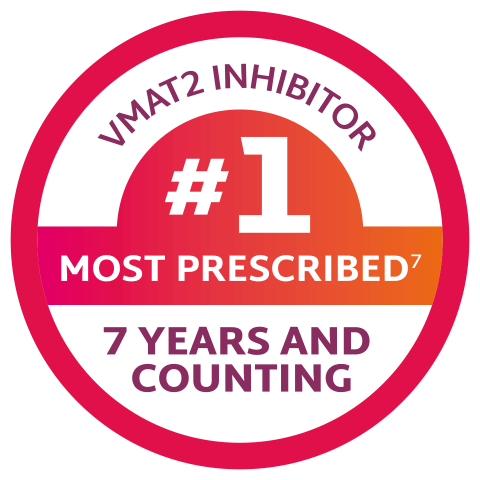FOR ADULTS WITH TARDIVE DYSKINESIA (TD)
Achieving REMISSION with INGREZZA
Rapid reductions in TD severity as early as 2 weeks.1-3,* 59% of patients achieved remission at 48 weeks.2,4,†
*Post hoc analysis from KINECT 3. Primary endpoint was change in AIMS total score (80 mg -3.2 [n=70] vs -0.1 [n=69] for placebo) from baseline to Week 6.
†Post hoc analysis from open-label KINECT 4. Remission defined as ≤1 on each AIMS item 1-7 at Week 48. Results are descriptive.
FOR ADULTS WITH TARDIVE DYSKINESIA (TD)

HIGHLY EFFECTIVE1,*
More than reductions in TD severity—achieve remission with INGREZZA1,4,5,†
SEE REMISSION DATAPROVEN ACROSS THE WIDEST RANGE OF PATIENTS1,10
EXPLORE DOSING

FOR ADULTS WITH HUNTINGTON’S DISEASE (HD) CHOREA
Achieving control with INGREZZA
Rapid and sustained chorea reductions observed with INGREZZA as early as 2 weeks and through 2 years1,2,11,§
Change in TMC score from baseline through 104 weeks in interim analysis of long-term, open-label study.
VIEW HD CHOREA EFFICACY
CONNECT WITH A REPRESENTATIVE
Contact a rep, request INGREZZA samples, sign up for email updates, and more.
CONTACT A REP| ‡ |
Based on in vitro VMAT2 binding affinity of dihydrotetrabenazine (HTBZ) metabolites and the primary active metabolite of INGREZZA, + α HTBZ. The clinical significance of in vitro data is unknown and is not meant to imply clinical outcomes. |
| § |
Change in TMC score from baseline through 104 weeks in interim analysis of long-term, open-label study. |
REFERENCES:
- INGREZZA [package insert]. San Diego, CA: Neurocrine Biosciences, Inc.
- Data on file. Neurocrine Biosciences, Inc.
- Hauser RA, Factor SA, Marder SR, et al. KINECT 3: a phase 3 randomized, double-blind, placebo-controlled trial of valbenazine for tardive dyskinesia. Am J Psychiatry. 2017;174(5):476-484.
- Correll CU, Citrome L, Singer C, et al. Sustained treatment response and global improvements with long-term valbenazine in patients with tardive dyskinesia. J Clin Psychopharmacol. 2024;44(4):353-361.
- Correll CU, Cutler AJ, Kane JM, McEvoy JP, Liang GS, O’Brien CF. Characterizing treatment effects of valbenazine for tardive dyskinesia: additional results from the KINECT 3 Study. J Clin Psychiatry. 2018;80(1):18m12278.
- Harriott ND, Williams JP, Smith EB, Bozigian HP, Grigoriadis DE. VMAT2 inhibitors and the path to INGREZZA (valbenazine). Prog Med Chem. 2018;57(1):87-111.
- Grigoriadis DE, Smith E, Hoare SRJ, Madan A, Bozigian H. Pharmacologic characterization of valbenazine (NBI-98854) and its metabolites. J Pharmacol Exp Ther. 2017;361(3):454-461.
- Brar S, Vijan A, Scott FL, et al. Pharmacokinetic and pharmacologic characterization of the dihydrotetrabenazine isomers of deutetrabenazine and valbenazine. Clin Pharmacol Drug Dev. 2023;12(4):447-456.
- Skor H, Smith EB, Loewen G, O’Brien CF, Grigoriadis DE, Bozigian H. Differences in dihydrotetrabenazine isomer concentrations following administration of tetrabenazine and valbenazine. Drugs R D. 2017;17(3):449-459.
- Deutetrabenazine [package insert]. Parsippany, NJ: Teva Neuroscience, Inc.
- Stimming EF, Claassen DO, Kayson E, et al. Safety and efficacy of valbenazine for the treatment of chorea associated with Huntington’s disease (KINECT-HD): a phase 3, randomised, double-blind, placebo-controlled trial. Lancet Neurol. 2023;22(6):494-504.
- Data on file as of Q3 2024. Neurocrine Biosciences, Inc.


